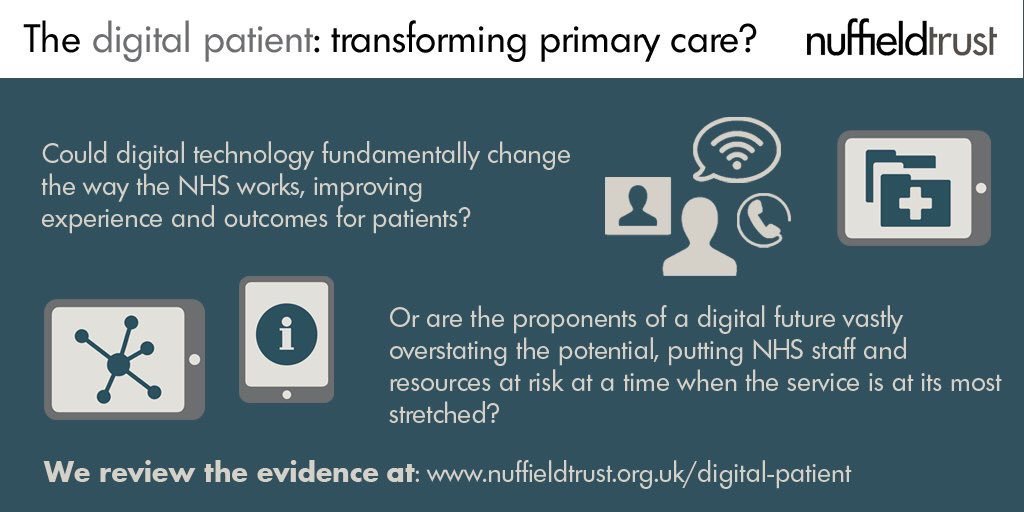
In a weekly column, alternately written by Lucien Engelen, Maarten Steinbuch, Carlo van de Weijer, and Tessie Hartjes, E52 tries to find out what the future will look like. All four contributors – sometimes accompanied by guest bloggers – are working on technologies that can provide solutions to the problems of our time. This Sunday, it‘s Lucien Engelen’s turn.
Here are all the prior editions of [TOMORROW IS GOOD]
Last November the (independent) health charity Nuffield Trust published a report on the digitalization of primary care by the ‘Digital patient”.
The report finds that patient-facing technology is already showing promise that it can improve care for patients and reduce strain on the stretched health service – particularly for people with long-term conditions such as diabetes or COPD. However, this rapidly evolving market comes with risks. Many apps, tools, and devices have not been officially evaluated, meaning that their effectiveness is unknown. In some cases, technology can increase demand for services, disengage staff and have the potential to disrupt the way that patients access care.
Moreover, the report warns that policy-makers and politicians should avoid assuming that self-care-enabling technology will produce significant savings, at least in the short term.
The report also presents a series of lessons and recommendations to NHS professionals, leaders and policy-makers about how best to harness the potential of technology and avoid the pitfalls.
It explored the impact of seven types of digital services offered by the NHS:
1 Wearables and monitoring technology
2 Online triage tools
3 Online sources of health information and advice, targeted interventions and peer support
4 Online appointment booking and other transactional services
5 Remote consultations
6 Online access to records and care plans
7 Apps
The lead author Sophie Castle-Clark said:
“But this technology could be a double edged sword, and there’s still a lot we don’t know. Without regulation and a careful look at the evidence – not all of which is compelling – these digital tools could compromise the quality of care and disrupt the way care is provided.”
It is a comprehensive report that outlines and confirms the pathway we also took at Radboud University Medical center through our REshape Center: a techno-optimistic approach with a skeptical view on the scientific validation of the developments. So that might make us techno-realists 😉
Happy reading, and let’s make 2017 a great year for health(care) with a human touch aided by technology to tackle the grand challenges we face.
I would love to read your suggestions below!
You might like some of the other ‘glass half full or empty’ blogs I wrote :
1 The power of the Human Touch. About the balance between technology and ‘being there’
2 Climate change in health(care). About the denial and neglect of the rising digital age in healthcare.
3 Always everywhere internet from space. On how free internet from space will make internet access everywhere on the globe possible.
Last November the (independent) health charity Nuffield Trust published a report on the digitalization of primary care by the ‘Digital patient”.
The report finds that patient-facing technology is already showing promise that it can improve care for patients and reduce strain on the stretched health service – particularly for people with long-term conditions such as diabetes or COPD. However, this rapidly evolving market comes with risks. Many apps, tools and devices have not been officially evaluated, meaning that their effectiveness is unknown. In some cases, technology can increase demand for services, disengage staff and have the potential to disrupt the way that patients access care.
Moreover, the report warns that policy-makers and politicians should avoid assuming that self-care-enabling technology will produce significant savings, at least in the short term.
The report also presents a series of lessons and recommendations to NHS professionals, leaders and policy-makers about how best to harness the potential of technology and avoid the pitfalls.
It explored the impact of seven types of digital services offered by the NHS:
Wearables and monitoring technology
Online triage tools
Online sources of health information and advice, targeted interventions and peer support
Online appointment booking and other transactional services
Remote consultations
Online access to records and care plans
Apps
The lead author Sophie Castle-Clark said :
“But this technology could be a double edged sword, and there’s still a lot we don’t know. Without regulation and a careful look at the evidence – not all of which is compelling – these digital tools could compromise the quality of care and disrupt the way care is provided.”
It is a comprehensive report that outlines and confirms the pathway we also took at Radboud University Medical center through our REshape Center : a techno-optimistic approach with a skeptical view on the scientific validation of the developments. So that might make us techno-realists 😉
Happy reading, and let’s make 2017 a great year for health(care) with a human touch aided by technology to tackle the grand challenges we face.
I would love to read your suggestions below!
You might like some of the other ‘glass half full or empty’ blogs i wrote :
The power of the Human Touch. About the balance between technology and ‘being there’
Climate change in health(care). About the denial and neglect of the rising digital age in healthcare.
Always everywhere internet from space. On how free internet from space will make internet access everywhere on the globe possible.




